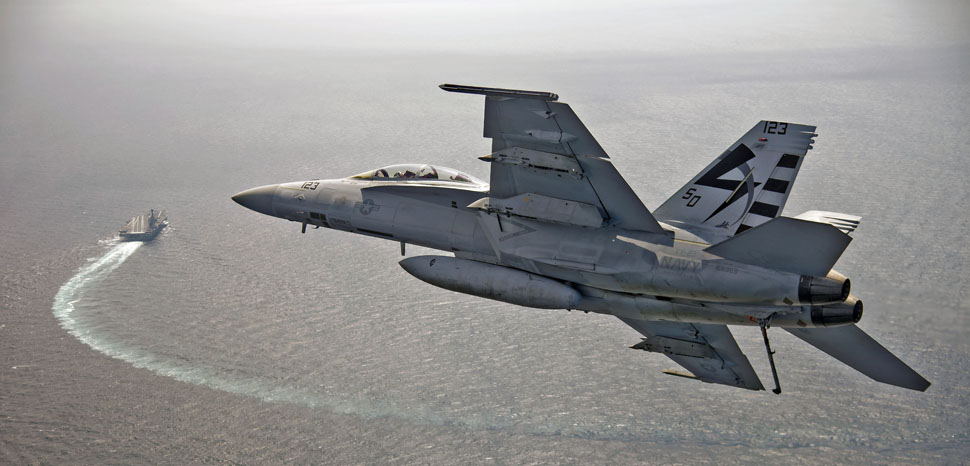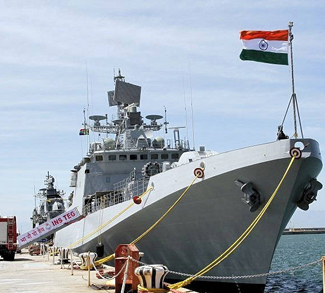It almost goes unquestioned now that great power politics is back, and consequently the role of national navies will continue to grow. States with global aspirations know perfectly well that without a superb navy it is nearly impossible to sustain a great power status. In the case of the United States, the Navy is the sine qua non of US power, without which Washington’s influence would be limited to only the Western Hemisphere. The Navy is the backbone of American diplomacy, enabler of America’s influence in remote corners of the globe, and the guarantor of global stability and prosperity. However, the United States’ maritime supremacy is increasingly being challenged and new estimates raise the possibility of China’s PLA Navy achieving parity in the near future.
These developments are not going unnoticed, and Washington is waking up to China’s challenge, which promises to turn various international waters into contested zones. Indeed, the 21st century will be one of naval competition between an established seafaring power and a land power increasingly turning its focus toward the seas.
As a maritime nation, the United States has a deep appreciation for its naval power projection. Some of the major wars of the past two centuries would have been impossible to win without the warships that enabled America’s entrance into these war zones as well as the maintenance of open lanes of supply and communications. History provides myriad examples on the impact of naval forces during state-to-state conflict. For instance, had Germany succeeded in enclosing the European continent by denying access to Anglo-American troops through the maritime domain in both World Wars, German victory would have almost certainly been inevitable. Additionally, both British and American naval forces exploited German dependence on seaborne trade by blockading the maritime trade routes depriving Berlin of its economic lifeline.
History also illustrates the correlation between the shrinking of blue-water navies sustaining the global order and outbreaks of previously contained conflicts. For example, among key factors that empowered Japanese aggression in the Pacific was the naval disarmament initiated by the Washington Naval Conference. Though Japan eventually ignored the limitations set by the agreement, both Washington and London continued to adhere to the treaty partially due to the looming economic depression. Furthermore, former Secretary of Navy John Lehman in his recent book Oceans Ventured: Winning the Cold War at Sea, makes a strong case against naval reductions citing the tragic consequences they produce. Consider the outbreak of the Korean War which was somewhat the outcome of President Truman’s campaign to drastically reduce the size of the Navy and curtail its influence. As a staunch supporter of air power, Truman believed that in the age of strategic bombers naval power would become redundant. Hence, the Truman-backed naval disarmament shrank the size of the Navy by almost 100 ships, leaving only five aircraft carriers for global missions. The unilateral reduction of naval forces including the marines, encouraged China and the Soviet Union to adopt a more hawkish posture in the Korean Peninsula. As a result, in 1950 the North Koreans – emboldened no doubt by America’s naval disarmament– invaded the South. Truman would soon realize that the Navy was essential for imposing a blockade of the Peninsula, and it lacked the necessary number of ships to enforce the American position in the region. The immediate response was the reversal of previous policies and the commencement of a massive naval rearmament, which included reactivation of abandoned aircraft carrier programs.
Continental powers too, have long had aspirations for maritime supremacy. After all, many land powers had to eventually build fleets to beat their maritime foes at sea. Land-locked Sparta went to sea to beat Athens at her own game. Similarly, the Soviet Union initiated a massive naval build-up to challenge the U.S. and her allies in international waters. Before Admiral Gorshkov was able to elevate the Soviet Union to its naval glory, both Stalin and Khrushchev experienced first-hand how crippling the lack of sea power leverage can be. Stalin could not fully intervene in the Spanish Civil War due to the weakness of the Soviet navy. Khrushchev, upon assuming the leadership of the Communist Party, dismantled the Naval Ministry of the Soviet Union and fired Captain-in-Chief Admiral Kuznetsov for entertaining blue-water navy aspirations. Then as the Cuban Crisis unfolded, the Soviet navy was unable to enforce the Kremlin’s stance, thereby serving as a humiliating wake-up call for Moscow. Finally, it was Khrushchev’s dismissal that unleashed Admiral Gorshkov’s blue-water navy that became a global force.
The role of the Navy in winning the Cold War cannot be underestimated. Apart from checking adversaries worldwide it engaged the Soviet Union in a naval competition, which the latter could not sustain. In the last decade of the Soviet Union, the Raegan Administration launched an immense naval build-up to create a 600-ship navy. The Navy had once again witnessed major cuts during the Carter Administration, while the Soviets enhanced their naval capabilities. Operation Oceans Ventured ’81 set the stage for enormous naval exercises for the remainder of the decade continuously deploying warships to the distant shores of the Soviet Union. As a response, the Soviet Union began conducting major exercises, dramatically increasing its naval expenditure. The attempt to keep on par with the U.S. unequivocally contributed to the eventual collapse of the Soviet economy.
With the breakup of the Soviet Union, virtually all geopolitical calculations changed. The United States became a victim of her own success and reduced the size of the Navy. There was simply no power that could challenge the U.S. therefore the calls for defense cuts intensified. Today, however, the United States and her allies exist quite in a different world. The post-Cold War world as we know it is coming to an end. The United States is facing an adversary who promises to challenge America’s global influence in multiple realms. That adversary is, of course, China. Having flown under the radar for the past several decades, the Chinese are just starting to flex their muscles. Apart from the cyberspace, this rivalry will primarily play out in the maritime domain as evidenced by China’s robust shipbuilding and modernization programs. As Andrew Erickson argues, “China’s naval buildup is only part of an extraordinary maritime transformation—modern history’s sole example of a land power becoming a hybrid land-sea power and sustaining such an exceptional status. Underwriting this transition are a vast network of ports, shipping lines and financial systems, and—of course—increasingly advanced ships.”
Though the US Navy continues to be the most lethal and mightiest naval force in the world, China’s maritime expansion has raised questions over America’s naval supremacy in the long-run and revived the debates over naval force structure. It seems that policymakers and experts in Washington grasp the significance of keeping America’s naval dominance intact. Nonetheless, this realization is coupled with the burgeoning costs of maintaining such a powerful navy. The national goal is a 355-ship Navy, but many remain skeptical given the operating cost of current ships as well as the rising number of decommissioned ships. The most expensive assets of the U.S. Navy are of course the nuclear-powered aircraft carriers around which the strike group forms. The power projection of carriers is truly remarkable. Serving as land bases in international waters they bring air power to adversaries’ shores. The firepower of these seagoing giants has the capacity to devastate entire cities most of which are located in littoral zones. Additionally, in times of crises it is not always certain that American allies allow the use of land bases for airstrikes. Perhaps the most famous recent case is Turkey’s refusal to let the US military launch aircraft from the Incirlik air base during the Iraq invasion in 2003. As a result, some of the major strikes were conducted from a nearby carrier.
The utility of aircraft carriers cannot be denied, and America’s rivals have long envied the nation’s ability to build and operate such expensive and complex warships. However, the recent debates—while appreciating the role carriers play— have raised concerns over their applicability in 21st century. First and foremost, the new Ford-class is extremely costly with the recent one being more than $12 billion. To put this into perspective, Canada’s entire annual defence budget is $25 billion. Secondly, carriers take years to build and by the time they are ready for deployment, some of the technology built in is already outdated. Critics also point out the increasing vulnerabilities of aircraft carriers as rivals—China in particular—develop missile systems that can cause critical damage. Though an attack on a carrier would rapidly mobilize the United States in full force against the belligerent, the fact is that thousands of sailors operating a single carrier would be killed instantly.
The PLA Navy is still behind in terms of building carriers that match the technologically sophisticated Ford class behemoths. But to take the shortcut, China has developed the so called “carrier-killer” missiles or DF-21D. Harry Kazianis explains how these missiles operate: “The missile is mobile and can travel anywhere via a truck, making its detection difficult. When launched, the weapon is guided using over-the-horizon radars, new satellite networks, and possibly even drones or commercial vessels being used as scouts. The system also has a maneuverable warhead to help defeat missile-defense systems. When it does find its target, it can descend from the sky and strike at speeds approaching Mach 12. Worst of all, the missile has a range of 1,000 miles.”
Advantages and vulnerabilities taken into account, it doesn’t seem that the U.S. will reconsider aircraft carriers in the foreseeable future. In fact, the Navy is expecting to receive its next carrier in the coming years; it’s named after John F. Kennedy (CVN-79) and currently around half-way complete. As mentioned above, the decades to come will witness growing naval competition between China and the United States. The United States will maintain its maritime dominance in upcoming years. However, it is highly unlikely that the U.S. government will be able to dramatically increase the size of the Navy to counter China numerically. Bloated bureaucracy and rising costs will contribute to this issue. For this reason, the United States will continue emphasizing the need for burden-sharing with allies to compensate for the shrinking size of its fleet. China has a clear advantage over the U.S. in the South China Sea due to its geographic location. Therefore, it is in the interest of the United States to adopt a realist naval diplomacy to engage states in the region which are fearful of growing Chinese encroachment. It would be nearly impossible for the U.S. to counter China without reinvigorating its partnerships with Japan, South Korea, Thailand, Australia, India, New Zealand, and Singapore. Though a NATO-style alliance is unlikely in Asia, a coherent bloc would still keep China in check. Furthermore, calls among defense experts regarding allocating more funds to the Navy will grow, forcing the Pentagon to prioritize the domain where great power competition is emerging once again: the vast oceans.
The opinions, beliefs, and viewpoints expressed by the authors are theirs alone and don’t reflect the official position of Geopoliticalmonitor.com or any other institution.




